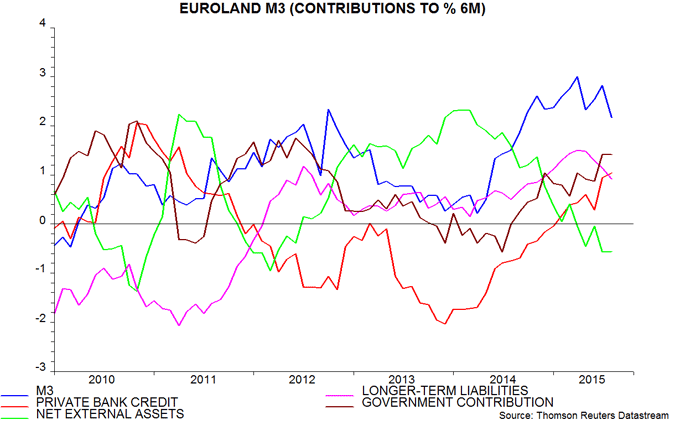Entries from September 20, 2015 - September 26, 2015
Eurozone money trends still positive but little QE impact
A pick-up in Eurozone narrow money (M1) growth from spring 2014 signalled that economic expansion would strengthen while deflationary risks were receding. Recently-revised national accounts data confirm this scenario. GDP grew at an annualised rate of 1.7% between the third quarter of 2014 and the second quarter of 2015, up from 0.7% in the prior three quarters. Domestic inflation, as measured by the annual increase in the GDP deflator, bottomed at 0.7% in the second quarter of 2014, rising to 1.2% a year later.
Note that the monetary pick-up was under way well before the ECB began to discuss QE in late 2014. Rather than QE, interest rate cuts in June and September played a key role, with their impact possibly magnified by the ECB supplying long-term liquidity tied to lowered official rates via its TLTRO programme.
Monetary trends continue to give a positive message for economic prospects, although August changes were softer than in recent months. M1 rose by 0.3% on the month while the broader M3 measure was unchanged. Both aggregates, however, had increased sharply in July and six-month growth rates remain solid, at 5.3% and 2.2% respectively, or 10.9% / 4.4% annualised – see first chart.
Previous posts on UK and Japanese experience argued that QE had little impact on monetary growth, because it triggered offsetting changes in private sector behaviour – in particular, sales (or reduced buying) of government securities by banks and an increase in net non-bank capital outflows (i.e. some liquidity flowed overseas). The evidence to date suggests that the current ECB programme is proving similarly ineffectual: six-month M3 growth of 2.2% in August compares with 2.6% in February, just before QE started. The M3 counterparts analysis confirms a drag from capital outflows: the impact of changes in banks’ net external asset position on six-month M3 growth has moved from +0.1 percentage points (pp) in February to -0.6 pp in August – second chart. In addition, banks sold €51 billion of government securities in the six months to August versus purchases of €41 billion in the prior six months.
Respectable economic growth, reviving inflation and still-positive monetary trends argue against further policy easing. If it were required, there is little reason to believe that additional QE would be effective.


UK GDP revisions to show stronger recovery
GDP revisions to be published by the Office for National Statistics (ONS) on 30 September will reveal significantly stronger growth in recent years, helping to explain the “productivity puzzle” and confirming that the double / triple dip scares of 2012 and 2013 were wide of the mark.
The ONS has already indicated the scale of revisions up to the fourth quarter of 2013; the 30 September release will extend the process to the present. The currently-available numbers show that the recovery was weaker than previously thought in 2010 but significantly stronger over 2011-2013. GDP is now estimated to have risen by a cumulative 6.0% between the fourth quarters of 2010 and 2013, equivalent to 2.0% at an annualised rate, versus a prior 4.2%, or 1.4% annualised.
GDP surpassed its pre-recession peak in the second quarter of 2013, one quarter earlier than previously thought.
GDP growth in calendar 2013 has been raised from 1.7% to 2.2%. The consensus at the time was for a sub-1% outcome, with much talk – notably from the IMF – of the risk of a recession (in contrast to the positive view taken here).
The end-September release may extend the upward revisions to growth since the fourth quarter of 2013. Even if the quarterly path since then is unchanged, however, the upgrades to earlier data imply that the GDP increase in calendar 2014 will be raised from 3.0% to 3.3%.
The revisions reflect a combination of methodological changes and new data. According to the ONS, the biggest impact has come from measures to improve coverage of small business activity and capture income concealed by tax evasion. The revisions could affect sectoral financial balances (i.e. income minus spending); as previously discussed, the household sector is currently estimated to be running a deficit.
The revisions are unlikely to alter MPC thinking: the direction, if not the scale, was expected and the MPC will attribute most of the upgrade to better supply-side performance, implying little change to its estimate of slack. They are potentially more significant for fiscal policy, since they may result in the Office for Budget Responsibility (OBR) raising its estimate of trend GDP growth, in turn boosting revenue forecasts. The scale of fiscal adjustment needed to meet targets, therefore, may be smaller than the OBR judged at the time of the July Budget.


